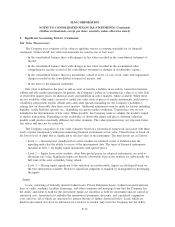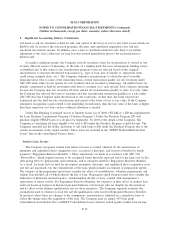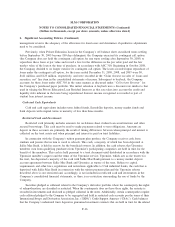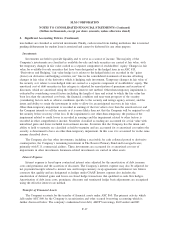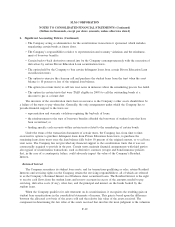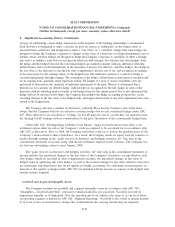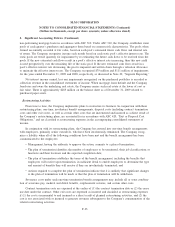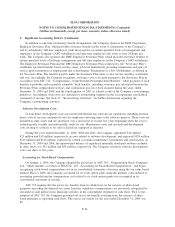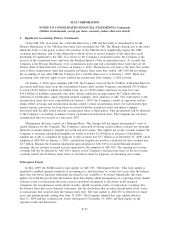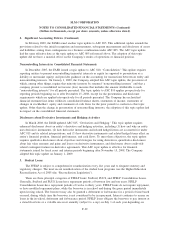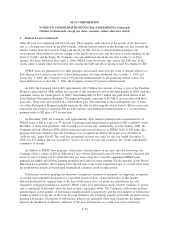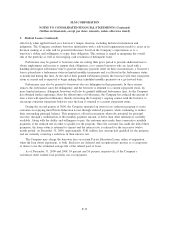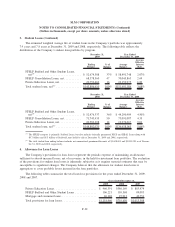Sallie Mae 2009 Annual Report Download - page 149
Download and view the complete annual report
Please find page 149 of the 2009 Sallie Mae annual report below. You can navigate through the pages in the report by either clicking on the pages listed below, or by using the keyword search tool below to find specific information within the annual report.2. Significant Accounting Policies (Continued)
In accordance with ASC 350, Step 1 of the goodwill impairment analysis consists of a comparison of the
fair value of the reporting unit to its carrying value, including goodwill. If the carrying value of the reporting
unit exceeds the fair value, Step 2 in the goodwill impairment analysis is performed to measure the amount of
impairment loss, if any. Step 2 of the goodwill impairment analysis compares the implied fair value of the
reporting unit’s goodwill to the carrying value of the reporting unit’s goodwill. The implied fair value of
goodwill is determined in a manner consistent with determining goodwill in a business combination. If the
carrying amount of the reporting unit’s goodwill exceeds the implied fair value of the goodwill, an impairment
loss is recognized in an amount equal to that excess.
Other acquired intangible assets, which include but are not limited to tradenames, customer and other
relationships, and non-compete agreements, are also accounted for in accordance with ASC 350. Acquired
intangible assets with definite or finite lives are amortized over their estimated useful lives in proportion to
their estimated economic benefit. Finite-lived acquired intangible assets are reviewed for impairment using an
undiscounted cash flow analysis when an event occurs or circumstances change indicating the carrying amount
of a finite-lived asset or asset group may not be recoverable. An impairment loss would be recognized if the
carrying amount of the asset (or asset group) exceeds the estimated undiscounted cash flows used to determine
the fair value of the asset or asset group. The impairment loss recognized would be the difference between the
carrying amount and fair value. Indefinite-life acquired intangible assets are not amortized. They are tested for
impairment annually as of September 30 or at interim periods if an event occurs or circumstances change that
would indicate the carrying value of these assets may be impaired. The annual or interim impairment test of
indefinite-lived acquired intangible assets is based primarily on a discounted cash flow analysis.
Guarantor Servicing Fees
The Company provides a full complement of administrative services to FFELP Guarantors including
guarantee issuance, process, account maintenance, and guarantee fulfillment services for Guarantor agencies,
the U.S. Department of Education (“ED”), educational institutions and financial institutions. The fees
associated with these services are recognized as earned based on contractually determined rates. The Company
is party to a Guarantor Servicing contract with United Student Aid Funds, Inc. (“USA Funds”), which
accounted for 86 percent, 85 percent and 86 percent of guarantor servicing fees for the years ended
December 31, 2009, 2008, and 2007, respectively.
Contingency Fee Revenue
The Company receives fees for collections of delinquent debt on behalf of clients performed on a
contingency basis. Revenue is earned and recognized upon receipt of the borrower funds.
The Company also receives fees from Guarantor agencies for performing default aversion services on
delinquent loans prior to default. The fee is received when the loan is initially placed with the Company and the
Company is obligated to provide such services for the remaining life of the loan for no additional fee. In the
event that the loan defaults, the Company is obligated to rebate a portion of the fee to the Guarantor agency in
proportion to the principal and interest outstanding when the loan defaults. The Company recognizes fees
received, net of actual rebates for defaults, over the service period which is estimated to be the life of the loan.
Collections Revenue
The Company has purchased delinquent and charged-off receivables on various types of consumer debt
with a primary emphasis on charged-off credit card receivables, and sub-performing and non-performing
mortgage loans. The Company accounts for its investments in charged-off receivables and sub-performing and
F-22
SLM CORPORATION
NOTES TO CONSOLIDATED FINANCIAL STATEMENTS (Continued)
(Dollars in thousands, except per share amounts, unless otherwise stated)


